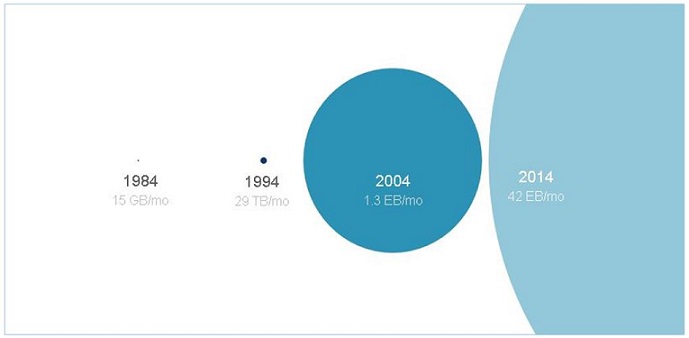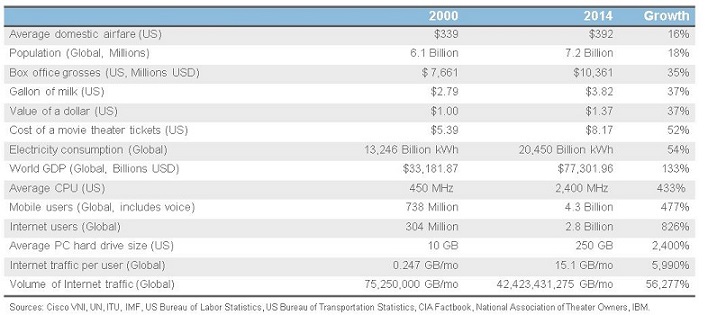
































I remember when 1 Mbps was big bandwidth. And 45 Mbps was unbelievably, outlandishly huge bandwidth. One spring day in 1995, at the headquarters of a large technology company outside of Dallas, there was excited chatter at the proverbial water cooler about the T3 access line that was being installed. A T3 line! Nearly 45 Mbps! Every thing reallyisbigger in Texas! We wondered what we would do with all that bandwidth, even though there were thousands of us at the location being served. Now, in 2015, the average broadband home has a 25 Mbps connection, and 20% of broadband homes worldwide have T3 speeds or higher, serving just the members of that household. And we now talk about yesterday's data speedsthe way "baby boomers" talk about the prices of convertibles and one-bedroom detached houses generations ago.
Reflections of this sort were frequent this summer, as the Visual Networking Index (VNI) team had a chance to catch our breaths from our usual schedules and take a look at the long history of Internet traffic. With this blog, we are posting our historical traffic figures for global Internet and IP traffic, from 1984 through 2014. (See end of blog post for data.) A second blog post to be published within a few weeks will explore this data in detail, but as a first step let's look at the sheer volume of the growth. It's huge. Too huge for a bar chart or line graph, so we've represented Internet traffic volume as bubbles below, but even here we had to exaggerate the 1984 and 1994 bubbles to make them visible.

There are a few astounding figures that emerge from looking at the historical data.
It may be a bit unfair to take 1984 as our starting point for the increase in Internet traffic. After all, the nature of growth rates is that they will be absurdly high in the first few years of any even modestly successful product or industry, since the base starts from nothing and moves to something. Let's take 2000 as our starting point instead. It was the height of the Internet boom. Amazon and Google were already cornerstones of the online universe. And 2000 doesn't seem so very long ago by other measures. A gallon of milk costs about the same as it did then, taking inflation into account. The differences in fashion since then have been more evolutionary than revolutionary. (At least that's what I tell myself when looking in the closet each morning.) Reality TV was already entertaining audiences in 2000, as they do today.
So perhaps the traffic growth rates are not so astronomical from 2000 to 2014, right? Not so. By the measure of Internet traffic, 2000 seems very distant indeed. Internet traffic in 2014 was over564 timeswhat it was in 2000. For fun, we've compiled a mixed bag of metrics for a quick "then and now" comparison of 2000 and 2014.

In the growth column, Internet traffic dominates the list, by far. There are few metrics in any industry that compare. Traffic is a summary metric that reflects multiple facets of Internet evolution. Internet traffic is the culmination not only of user and device growth, but of growing usage, application trends, and increasing bandwidth availability. While adoption figures and download statistics signal the transformative social impact of the Internet, traffic metrics account for our sense of the Internet as something transcendent; our sense that it is growing faster than our ability to fathom.
How high can Internet consumption go?
Is there a limit? We are often asked this question as we describe the latest VNI findings throughout the year. While year-over-year Internet growth rates have been leveling out for some time, we don't expect them to drop below 20% in the foreseeable future. There is strong growth coming from mobile (cellular) networks, content is increasingly high-definition, and machines are starting to populate the Internet at a rapid pace. Even without these growth drivers, the fact remains that people continue to consume a lot of content that doesn't yet touch the Internet. While Internet traffic is just 15 Gigabytes per month, individuals consume hundreds of gigabytes of additional data in the form of broadcast television, broadcast radio, digital content stored on storage drives, and (last but not least) video games amount to hundreds of gigabytes per month. Just in the last year, on-board console storage increased enough to allow gamers to download their graphically rich games instead of acquiring them on disc. The game downloads are moving the needle on traffic, and we expect video game downloads to account for a full 5% of fixed consumer Internet traffic by 2019.
Not long ago, our team played around with a few high-consumption scenarios to predict key bandwidth drivers. We ended up convinced that certain applications could require a household bandwidth of 1 Gbps, and even 10 Gbps of bandwidth would not be excessive. One of the key 'killer apps' for bandwidth, mundane is it sounds, is file transfer. Instant file transfer requires high bandwidth. Transferring a 10 Gigabyte file within a few minutes requires 300 Mbps. Instant file transfer is required for true cloud applications, real-time backup and cloud storage, and certain kinds of data-intensive telework. Consider an on-call doctor who needs to receive a 1 Gigabyte medical image in real-time while consulting with colleagues about a patient. To receive this file in 4 seconds would require bandwidth of 2 Gbps.
If there is a natural limit to Internet consumption, we haven't reached it yet. There may a period of slower Internet growth before we see some of these trends become prevalent, but the potential is there for substantially more Internet consumption in the future. Perhaps in 2030 we will be reflecting with amusement about how we used to think 15 Gigabytes per month per user was an impressive amount of traffic.
Stay tuned for the next blog post, to be published within a few weeks, where we will explore the inflections points of traffic growth over the past 30 years.
Historical Global Internet Traffic Data, 1984 through 2014
| Year | Traffic (GB/mo) |
| 1984 | 15 |
| 1985 | 33 |
| 1986 | 65 |
| 1987 | 128 |
| 1988 | 252 |
| 1989 | 498 |
| 1990 | 1,000 |
| 1991 | 2,002 |
| 1992 | 4,444 |
| 1993 | 8,715 |
| 1994 | 25,830 |
| 1995 | 150,500 |
| 1996 | 1,200,000 |
| 1997 | 5,000,000 |
| 1998 | 11,200,000 |
| 1999 | 25,500,000 |
| 2000 | 75,250,000 |
| 2001 | 175,000,000 |
| 2002 | 356,000,000 |
| 2003 | 681,050,000 |
| 2004 | 1,267,800,000 |
| 2005 | 1,802,745,619 |
| 2006 | 2,910,579,371 |
| 2007 | 4,477,367,718 |
| 2008 | 6,491,159,470 |
| 2009 | 9,301,984,735 |
| 2010 | 13,751,003,569 |
| 2011 | 19,974,008,812 |
| 2012 | 26,214,897,380 |
| 2013 | 32,798,830,927 |
| 2014 | 42,423,169,029 |
Have questions or comments -Tweet us @CiscoVNI!
 Горячие метки:
Интернет в интернете
M2M
mobile devices
ip traffic
mobile vni
mobile data traffic
global mobile data
mobile users
mobile to mobile connections
Горячие метки:
Интернет в интернете
M2M
mobile devices
ip traffic
mobile vni
mobile data traffic
global mobile data
mobile users
mobile to mobile connections